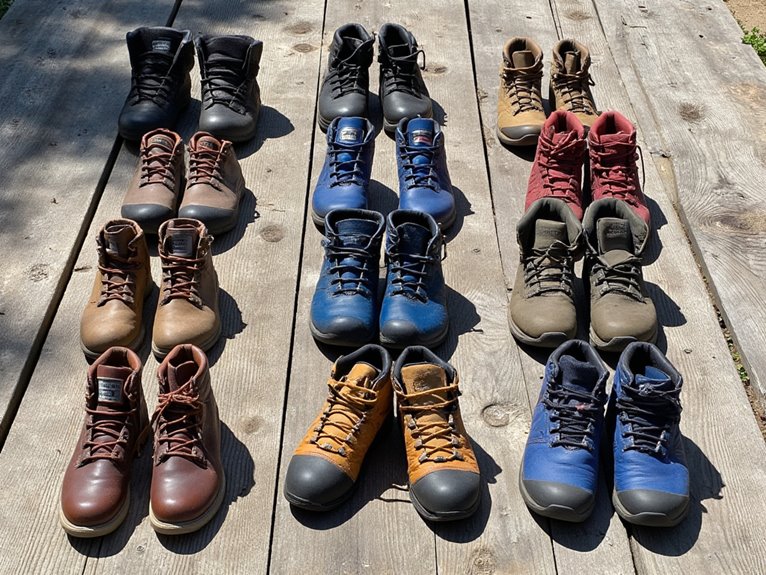Best Shoes for Backpacking
I’ve tested dozens of backpacking shoes across rocky trails and stream crossings, and I’ll recommend the Merrell Moab 3 for reliable all-terrain performance with Gore-Tex waterproofing, KEEN Targhee 3 for superior moisture-wicking construction, and Merrell Speed Strike 2 for excellent traction on technical terrain. Water shoes like SOBASO work for stream crossings but aren’t suitable for extended hiking. Choose waterproof boots under 2.5 pounds with 5-6mm lug depth for rocky terrain. The complete selection guide below covers specific terrain requirements and sizing considerations.
We are supported by our audience. When you purchase through links on our site, we may earn an affiliate commission, at no extra cost for you. Learn more. Last update on 18th December 2025 / Images from Amazon Product Advertising API.
Notable Insights
- Merrell Moab 3 series offers proven reliability with Gore-Tex waterproofing and requires zero break-in time for immediate comfort.
- KEEN Targhee 3 provides reliable construction with moisture-wicking lining and dependable waterproof protection for challenging terrain.
- Choose shoes weighing under 2.5 pounds with aggressive 5-6mm lug depth for optimal traction on rocky surfaces.
- Order one size different than normal due to inconsistent sizing across brands and test multiple sizes before purchasing.
- Select Gore-Tex or eVent membrane shoes for wet conditions and mid-cut designs for ankle stability on uneven trails.
Quick Dry Water Shoes for Men Women – Aqua Swim Beach Hiking Sandals
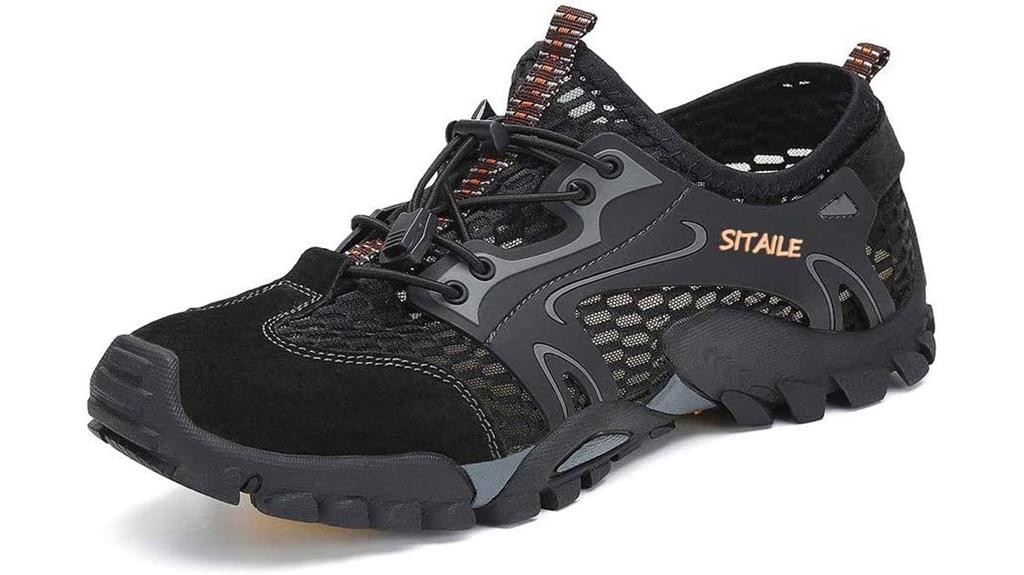
Quick-dry water shoes excel as backpacking footwear when your adventure includes stream crossings, rocky shorelines, or unpredictable weather conditions. These shoes feature leather suede construction with quick-drying mesh panels that provide excellent airflow. You’ll appreciate their performance in extreme heat—they’re tested effective in 102° conditions. The sturdy sole handles rocky terrain while maintaining comfort during extended wear.
Sizing runs large, so order one size down from your normal shoe size. Users report size 10 fits like size 11, while 11.5 fits like size 10. The toe box accommodates wide feet, though some find it too roomy. Pull straps assist with quick on-off, essential for frequent water entries during backpacking.
Best For: Backpackers and outdoor enthusiasts who need versatile footwear for water activities, stream crossings, and hiking in hot climates with rocky terrain.
Pros:
- Excellent quick-drying capabilities with breathable mesh panels and leather suede construction
- Sturdy sole that handles rocky terrain while maintaining comfort during extended wear
- Effective performance in extreme heat conditions up to 102° with superior airflow
Cons:
- Sizing runs large and inconsistent, requiring customers to order one size down from normal
- Toe box may feel too roomy or wide for users who prefer a snugger fit
- Pull straps reported as too long by some users
SOBASO Water Shoes for Women and Men Quick Drying

SOBASO water shoes excel as lightweight aquatic footwear for backpackers who need versatile protection during river crossings, lakeside camping, and multi-terrain adventures. You’ll appreciate their quick-drying properties and superior traction on wet surfaces. The removable insole simplifies cleaning and accelerates drying time between uses.
However, you’ll encounter sizing inconsistencies that require careful attention. Many users recommend ordering one size smaller to prevent excessive foot movement during demanding activities. The shoes accommodate wider feet comfortably, but overtightening can cause blisters.
Durability remains problematic under strenuous conditions. While they perform adequately for light swimming and casual walking, sole separation and glue failure occur frequently during intensive use like portaging or extended hiking. For serious backpacking applications requiring robust foot support, consider upgrading to more substantial footwear.
Best For: Casual water activities like light swimming, pool walking, and lakeside camping where quick-drying lightweight footwear is needed, but not suitable for intensive hiking or users requiring substantial foot support.
Pros:
- Quick-drying properties with removable insoles for easy cleaning and faster drying between uses
- Superior traction on wet surfaces and comfortable fit for wider feet
- Lightweight design ideal for water-related activities and basic aquatic protection
Cons:
- Inconsistent sizing requires ordering one size smaller, with risk of blisters when overtightened
- Poor durability under strenuous conditions with frequent sole separation and glue failure
- Insufficient support for demanding activities like extended hiking or for users with foot conditions like plantar fasciitis
ROCKMARK Mens Waterproof Hiking Boots for Outdoor Activities
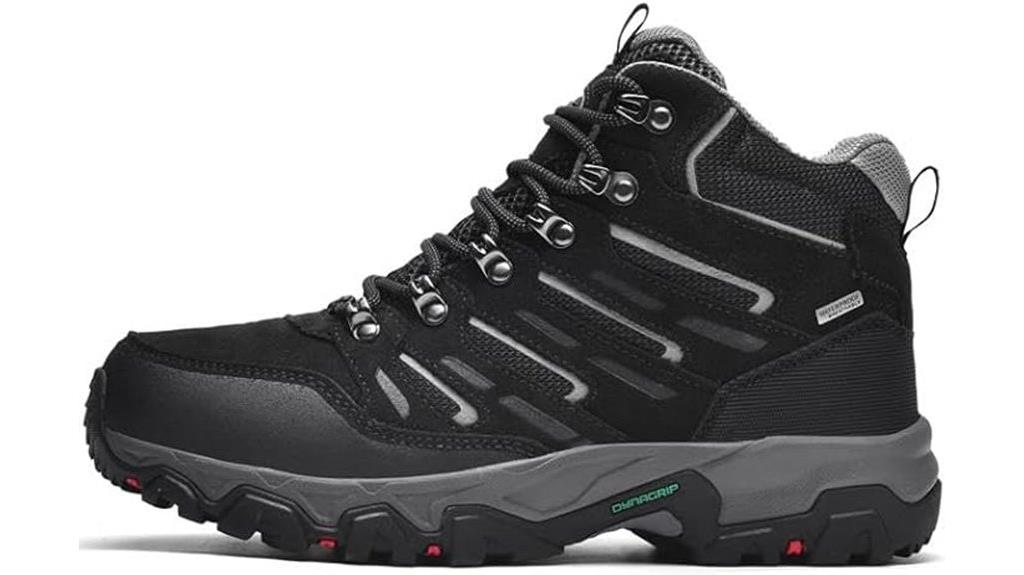
ROCKMARK Mens Waterproof Hiking Boots deliver reliable performance for backpackers with narrower feet who need dependable waterproofing without premium pricing. You’ll get effective traction on dirt, gravel, and tile surfaces with anti-slip soles that prevent ankle rolling during extended wear.
The waterproof construction passes real-world tests in heavy rain and water crossings. You’ll stay dry even when crossing streams, though insulation limits comfort to temperatures above 15°F. The lightweight leather-fabric construction won’t weigh you down on long trails.
However, you’ll need to replace the inadequate stock insoles with quality alternatives like Sole inserts for proper foot support. The tight toe box creates discomfort for wider feet, requiring careful sizing consideration before purchase.
Best For: Casual hikers and backpackers with narrower feet who need affordable waterproof boots for day hikes and outdoor activities in moderate weather conditions.
Pros:
- Reliable waterproof performance tested in heavy rain and stream crossings
- Effective anti-slip traction on various surfaces with good ankle stability
- Lightweight construction with stylish design suitable for both outdoor and casual wear
Cons:
- Tight toe box causes discomfort for users with wider feet
- Stock insoles provide inadequate support and require replacement
- Limited insulation restricts comfortable use to temperatures above 15°F
SHULOOK Mens Waterproof Hiking Boots Non-Slip Lightweight Outdoor Mid Top Ankle Boot
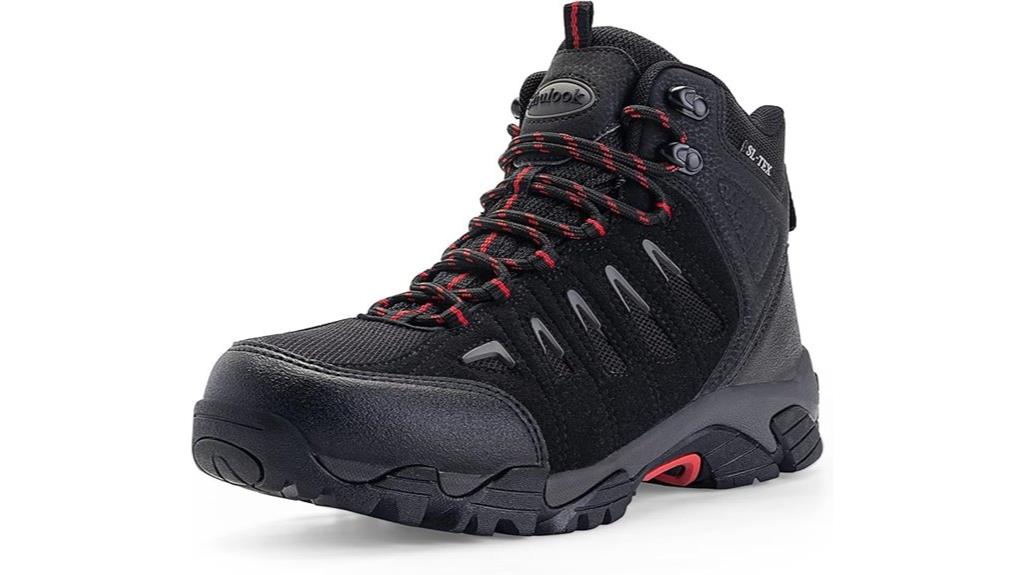
The waterproof barrier provides approximately three weeks of reliable protection before potential seepage occurs. You can expect 5-6 months of performance in demanding terrain conditions. The versatile design shifts seamlessly from trail to casual wear with khakis and polos.
Proper lacing technique prevents ankle rubbing when boots fit snugly at the top opening. These boots excel across varied terrain while maintaining their lightweight advantage throughout extended backpacking trips.
Best For: Hikers and outdoor enthusiasts seeking comfortable, lightweight boots for moderate trail conditions and casual wear who don’t require long-term waterproof protection.
Pros:
- Exceptional comfort and lightweight design that feels like high-top sneakers
- Versatile styling that transitions well from outdoor adventures to casual everyday wear
- True-to-size fit with breathable materials and good overall build quality
Cons:
- Waterproof protection fails after approximately 3 weeks with potential seepage issues
- Limited durability with expected lifespan of only 5-6 months in rough conditions
- May cause ankle rubbing if laced to the top when boots fit snugly
Merrell Mens Speed Strike 2 Hiking Shoe
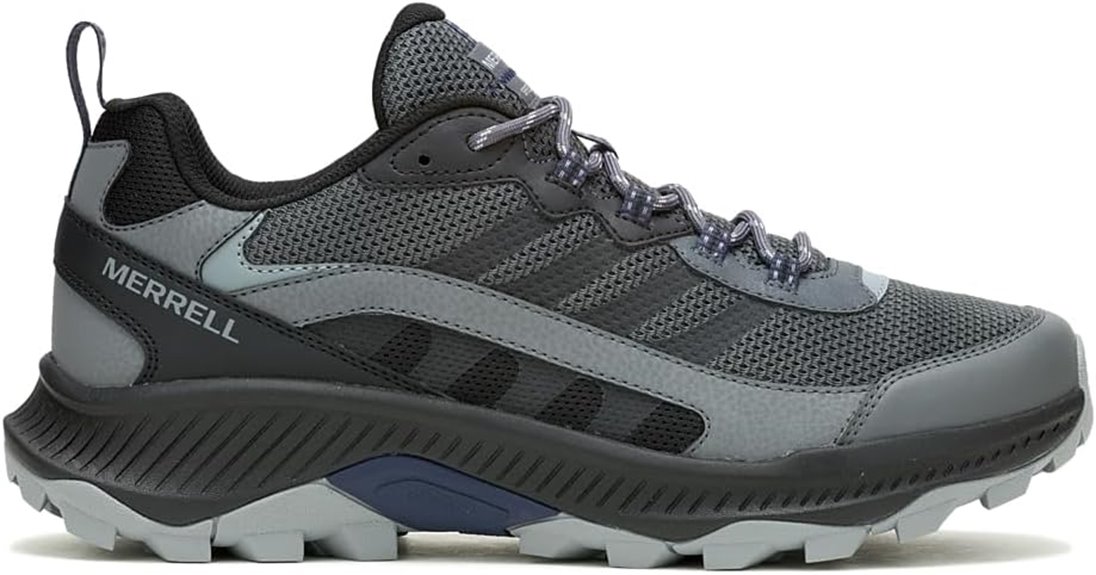
Merrell’s Speed Strike 2 delivers exceptional value for hikers with high arches and wide toe boxes who need versatile footwear that shifts seamlessly from trail to everyday wear. The athletic hybrid design features durable outdoor mesh uppers with reinforced toe and heel sections. You’ll appreciate the curve-lasted construction that accommodates extreme pronation while maintaining flexibility.
The sticky trail outsole provides confident grip on rocky terrain and gravel paths. Excellent cushioning delivers rebound on hard surfaces, though the shoe runs slightly narrow compared to other Merrell models. The breathable mesh construction handles rocky terrains effectively.
Color accuracy varies—marketed black appears more gray with lighter midsole tones than illustrated. You’ll find it performs well for light hiking, everyday use, and cycling activities, though wet-condition testing remains limited.
Best For: Hikers with high arches and wide toe boxes who need versatile footwear for light hiking, everyday wear, and cycling activities on rocky terrain.
Pros:
- Excellent cushioning with rebound on hard surfaces and sticky trail outsole for confident grip on rocky terrain
- Curve-lasted construction accommodates extreme pronation while maintaining flexibility for various foot types
- Versatile athletic hybrid design works well for trail hiking, everyday use, and cycling activities
Cons:
- Runs slightly narrow compared to other Merrell models, limiting fit options for some users
- Color inaccuracy with marketed black appearing more gray and lighter midsole than illustrated
- Limited testing under wet conditions leaves grip performance in soaking conditions uncertain
Merrell Womens Moab 3 Shoe
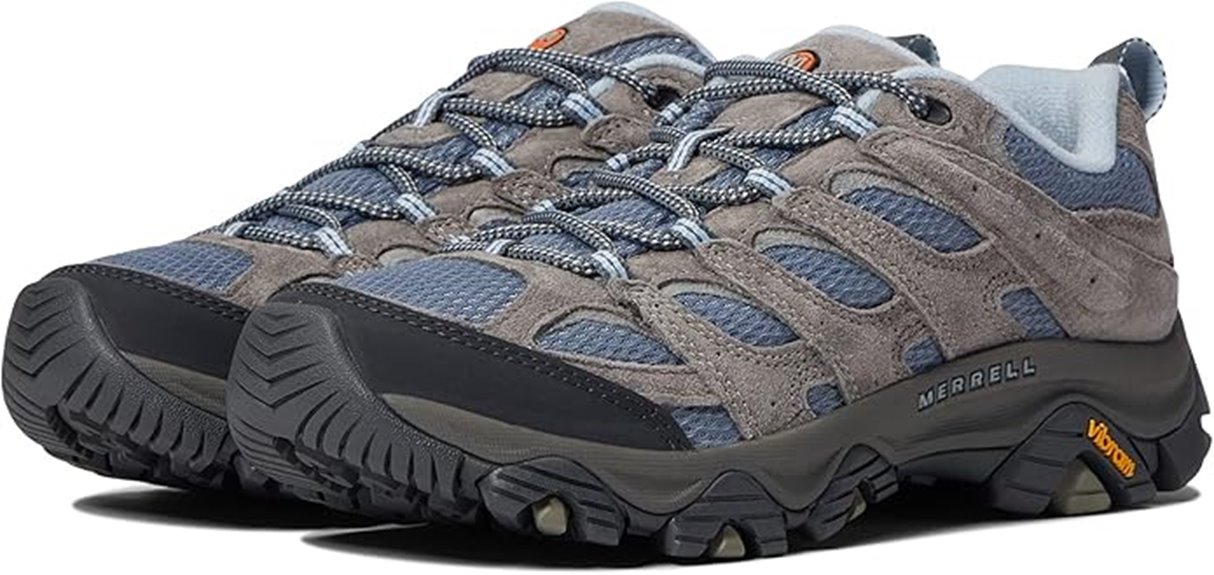
Women who prioritize immediate comfort and reliable performance on diverse trails will find exceptional value in the Moab 3’s proven design. You’ll experience zero break-in period with this bestselling hiking shoe that’s enabled 20 million outdoor enthusiasts to explore confidently. The supportive insole and cushioned EVA midsole provide shock absorption during extended backpacking trips.
You’ll appreciate the grippier Vibram® outsole‘s traction on loose gravel and wet surfaces. The Merrell Air Cushion system prevents blisters during long hikes while maintaining comfort through 12,000+ daily steps. Partially recycled fabrics add environmental value.
Sizing runs slightly large, so consider going down half a size for ideal fit. The wider options accommodate broader feet effectively.
Best For: Women seeking immediate comfort and reliable performance for hiking, daily walking, and outdoor activities who want a proven shoe with excellent traction and no break-in period required.
Pros:
- Zero break-in period with excellent out-of-the-box comfort and shock absorption from EVA midsole and Merrell Air Cushion system
- Superior traction on diverse terrains including loose gravel and wet surfaces thanks to grippier Vibram® outsole
- Exceptional durability with long-lasting construction that withstands extensive daily use of 12,000+ steps
Cons:
- Sizing runs large, requiring most users to go down half a size for proper fit
- May require aftermarket insoles for users needing additional arch support beyond the standard insole
- Limited break-in flexibility since the shoe comes fitted for immediate comfort rather than customizing to foot shape over time
Merrell Mens Moab 3 Hiking Shoe

Hikers seeking proven reliability and immediate comfort will find their match in the Merrell Mens Moab 3 Hiking Shoe, a footwear champion that’s dominated trails for over 15 years. This bestselling global hiker has enabled 25 million people to explore outdoors through its signature out-of-the-box comfort and proven durability.
The shoe features a round, deep toe box that accommodates thick socks while maintaining snug side support. Gore-Tex waterproof lining delivers all-weather protection without sacrificing breathability. Traction patterns provide reliable grip across varied terrain conditions.
Daily wear capability means fewer replacements over time, reducing long-term costs. You’ll appreciate the versatile design that shifts from technical hiking to casual activities seamlessly, making this a practical investment for serious backpackers.
Best For: Hikers and outdoor enthusiasts who prioritize immediate comfort, proven durability, and versatile footwear that performs across multiple activities from technical hiking to casual daily wear.
Pros:
- Proven 15-year track record with 25 million users demonstrating exceptional reliability and out-of-the-box comfort
- Gore-Tex waterproof lining provides all-weather protection while maintaining breathability for varied conditions
- Versatile design transitions seamlessly from technical hiking to casual activities, offering excellent value as multi-purpose footwear
Cons:
- Tall and rigid arch support may not accommodate all foot types comfortably
- Limited styling options compared to more casual shoe alternatives
- Higher initial cost compared to basic hiking footwear, though offset by durability
NORTIV 8 Mens Waterproof Hiking Shoes for Outdoor Trailing
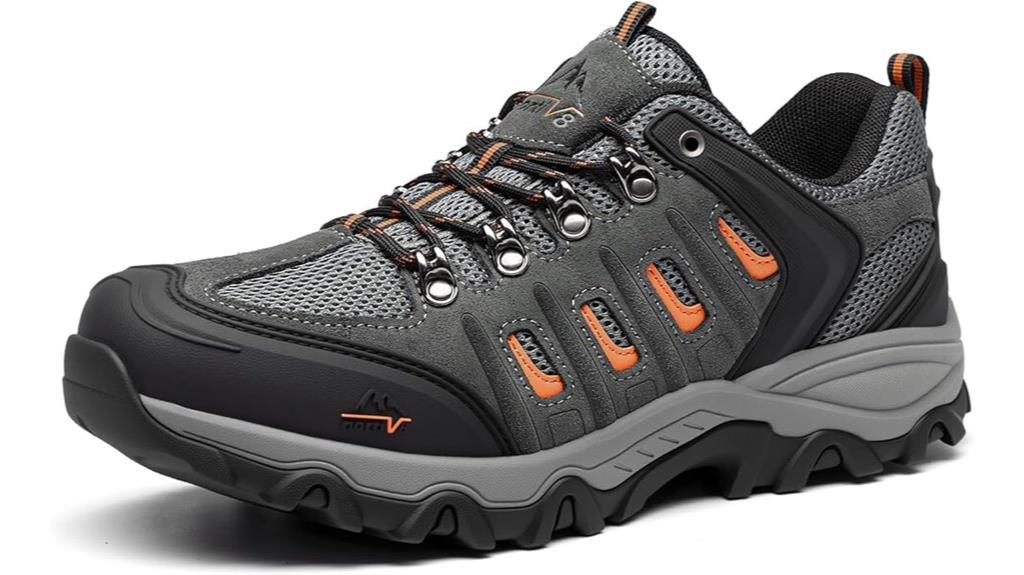
NORTIV 8 Men’s Waterproof Hiking Shoes bridge the gap between athletic sneakers and heavy-duty hiking boots, making them ideal for casual hikers who need reliable footwear without the bulk. You’ll find excellent traction on rocky surfaces across varied terrains like the Whites and Adirondacks. The shoes deliver high comfort during extended use, with users reporting successful 8-mile treks.
However, you should note they’re water-resistant rather than truly waterproof. Some users experience durability concerns with limited use. Sizing runs small compared to charts, so you’ll want to size up. The shoes work well for casual hiking and outdoor chores, though customer service issues exist for returns and defects.
Best For: Casual hikers who want comfortable, lightweight footwear for outdoor activities like trailing, trekking, and camping on varied terrains without the bulk of heavy-duty hiking boots.
Pros:
- High comfort levels during extended use with excellent traction on rocky surfaces
- Lightweight design that bridges the gap between sneakers and hiking boots
- Available in wide and half sizes for better fit customization
Cons:
- Water-resistant rather than truly waterproof, with mixed performance in wet conditions
- Sizing runs small compared to size charts, requiring users to size up
- Durability concerns and poor customer service for returns and defects
Kricely Mens Low Top Hiking Shoes Waterproof Suede Lightweight

Budget-conscious backpackers seeking an affordable waterproof option will find the Kricely Men’s Low Top Hiking Shoes positioned as a lightweight suede alternative to premium brands. You’ll receive true-to-size fit for most users, though some report running nearly a full size small. The lightweight construction provides adequate cushioning and arch support for extended hiking. However, the waterproof claims prove unreliable in field testing. Users report complete saturation after stepping in shallow puddles just two inches deep. Initial quality appears decent, but durability remains questionable compared to established brands like Columbia. Expect a manufacturing odor requiring 24-48 hours of airing before use.
Best For: Budget-conscious hikers who prioritize lightweight comfort over waterproof reliability and don’t mind potential sizing inconsistencies.
Pros:
- Super lightweight construction with good cushioning and arch support
- True-to-size fit for most users with comfortable feel during extended wear
- Affordable alternative to premium hiking shoe brands
Cons:
- Waterproof claims are unreliable, with shoes failing to keep feet dry in shallow puddles
- Inconsistent sizing with some users reporting shoes run nearly a full size small
- Strong manufacturing odor requiring 24-48 hours of airing before use
KEEN Mens Targhee 3 Low Height Waterproof Hiking Shoes
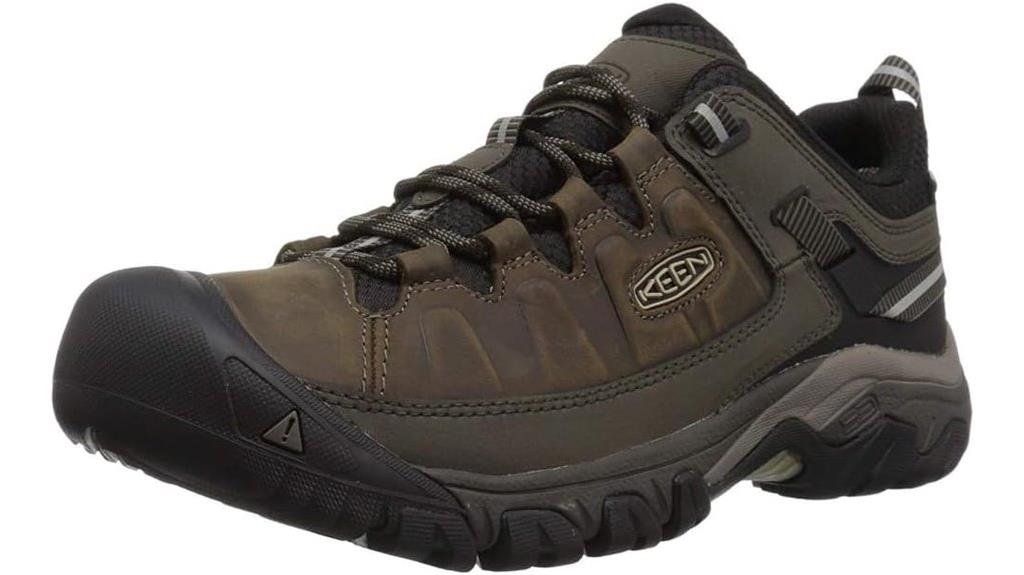
Adventure-seekers who demand reliable all-terrain performance will find the KEEN Men’s Targhee 3 Low Height Waterproof Hiking Shoe delivers exactly what backpacking expeditions require. Each shoe weighs 15.87 oz, featuring waterproof leather construction and moisture-wicking lining. You’ll appreciate the wider footwear form and Eco Anti-Odor technology that prevents bacterial growth during extended trips.
The leather sourcing meets Leather Working Group certification standards. You’ll get excellent arch support and true-to-size fitting. However, you should replace the factory shoelaces with longer ones for ideal lacing. Some users report reduced traction on rocky surfaces, so consider your terrain carefully. Water resistance testing in heavy rain conditions proves effective. Most customers experience years of durability.
Best For: Adventure-seekers and hikers who need durable, waterproof footwear with excellent arch support for all-terrain activities and extended outdoor expeditions.
Pros:
- Excellent waterproof performance with moisture-wicking lining and proven effectiveness in heavy rain conditions
- Superior durability and comfort with years of reported lifespan, true-to-size fitting, and excellent arch support
- Eco-friendly features including Anti-Odor technology, PFC-free water repellent, and leather from certified sustainable tanneries
Cons:
- Reduced traction on rocky terrain with some users reporting slippery performance on challenging surfaces
- Factory shoelaces are too short and require replacement with longer ones for optimal fit and lacing
- Mixed durability reports from heavy-use professionals who experience shorter lifespans due to lacing support failure
Factors to Consider When Choosing Shoes for Backpacking
I’ve tested dozens of backpacking shoes across various terrains, and five critical factors consistently determine whether you’ll love or regret your footwear choice. Your pack weight, trail conditions, and personal fit requirements will directly impact which shoe design performs best for your specific needs. Understanding these key variables before you buy will save you from blisters, wet feet, and premature gear failure on the trail.
Weight and Pack Load
When you’re calculating your base pack weight, every ounce matters—and your footwear represents one of the heaviest single items you’ll carry on your feet for thousands of steps each day. I recommend keeping your shoes under 2.5 pounds per pair for extended hikes. A reduction of just three to four ounces can greatly decrease leg fatigue over multi-day trips.
Lightweight materials like mesh uppers and EVA midsoles considerably reduce weight without sacrificing essential support. You’ll want breathable fabrics that resist water absorption—wet shoes can add several ounces of dead weight.
Your footwear choice directly impacts hiking speed and energy efficiency. Heavy boots force your legs to work harder with each step, multiplying fatigue exponentially over long distances.
Terrain and Trail Conditions
The trail beneath your boots determines every aspect of your footwear selection. Rocky, rugged terrain demands aggressive lugs with 5-6mm depth for maximum grip and reinforced rubber compounds rated above 70 Shore A durometer. I recommend shoes with rock plates or ESS shanks for puncture protection.
Wet conditions require Gore-Tex or eVent membranes with sealed seam construction. These barriers maintain breathability at 16,000+ g/m²/24hr while blocking moisture infiltration.
Uneven trails necessitate mid-cut designs extending 2-3 inches above the ankle joint. Look for TPU heel counters and structured medial posts for lateral stability.
Technical terrain calls for reinforced toe caps using abrasion-resistant materials like Kevlar or ballistic nylon. The toe box should extend 10-12mm beyond your longest toe for impact protection while maintaining forefoot flexibility for precise foot placement.
Waterproof Vs Water Resistant
Should you prioritize complete moisture protection or enhanced breathability? I’ll break down the key differences between waterproof and water-resistant footwear for backpacking.
Waterproof shoes use specialized materials and construction methods that completely prevent water penetration. They’ll keep your feet dry in heavy rain and stream crossings. However, their effectiveness diminishes over time through wear and environmental exposure, requiring proper maintenance.
Water-resistant shoes offer limited moisture protection but provide superior breathability and comfort. They’re ideal for mild conditions but fail during prolonged water exposure or heavy precipitation.
Consider your specific terrain and weather conditions when choosing. Waterproof options excel in wet climates, while water-resistant models work better for dry trails with occasional moisture. Performance ratings indicate breathability and durability differences between materials.
Fit and Sizing
Proper fit determines whether your backpacking adventure becomes a memorable journey or a painful ordeal. I recommend testing multiple sizes since shoes often run larger or smaller than expected. You’ll want a snug fit in rugged conditions to prevent excess movement that causes blisters during long hikes.
Consider your foot’s width and volume carefully. A shoe comfortable in length may still be unsuitable if the toe box is too tight or loose. Wide feet require specific designs that accommodate broader dimensions, while narrow fits create pressure points and reduce support.
I suggest trying shoes with thicker hiking socks to account for foot swelling during extended treks. This approach guarantees ideal fit and reduces discomfort risk when you’re miles from civilization.
Durability and Construction Quality
When selecting backpacking shoes, construction quality directly impacts your gear’s lifespan and your safety on challenging terrain. I recommend prioritizing high-quality materials like full-grain leather or premium suede, which resist cracking and maintain structural integrity under stress. Look for reinforced toe boxes and heel counters—these protective features absorb impact from rocks and roots while preventing premature breakdown.
Solid rubber outsoles provide superior traction and wear resistance compared to cheaper foam alternatives. I always check for replaceable insoles, which extend shoe life by allowing comfort upgrades without buying new footwear.
Before purchasing, I examine customer reviews for moisture resistance and abrasion performance reports. Consistent complaints about water penetration or rapid sole wear indicate subpar construction. Quality shoes withstand environmental punishment while maintaining protective function throughout extended backcountry use.
Breathability and Quick Drying
Two critical performance factors separate excellent backpacking shoes from mediocre ones: breathability and quick-drying capabilities. I prioritize shoes with breathable mesh uppers that facilitate continuous airflow around your feet. This design prevents overheating during extended hikes in hot climates while promoting sweat evaporation.
Quick-drying materials become essential when crossing streams or hiking through wet conditions. Shoes that retain moisture create breeding grounds for blisters and skin irritation. Quality backpacking footwear dries completely within 2-4 hours after water exposure.
The combination of these features proves invaluable on multi-day trips where foot hygiene directly impacts your hiking performance. Wet, poorly ventilated shoes compromise comfort and increase injury risk during prolonged outdoor activities.
On a final note
I’ve covered top-rated backpacking shoes ranging from $25 water shoes to $130 premium hiking boots. Each option addresses specific terrain and weather conditions. Water shoes excel in wet environments but lack ankle support. Mid-top boots provide stability on rocky trails. Low-cut shoes offer flexibility for day hikes. Consider your intended use, foot shape, and budget when selecting footwear. Proper fit prevents blisters and guarantees comfort during extended backpacking trips.

